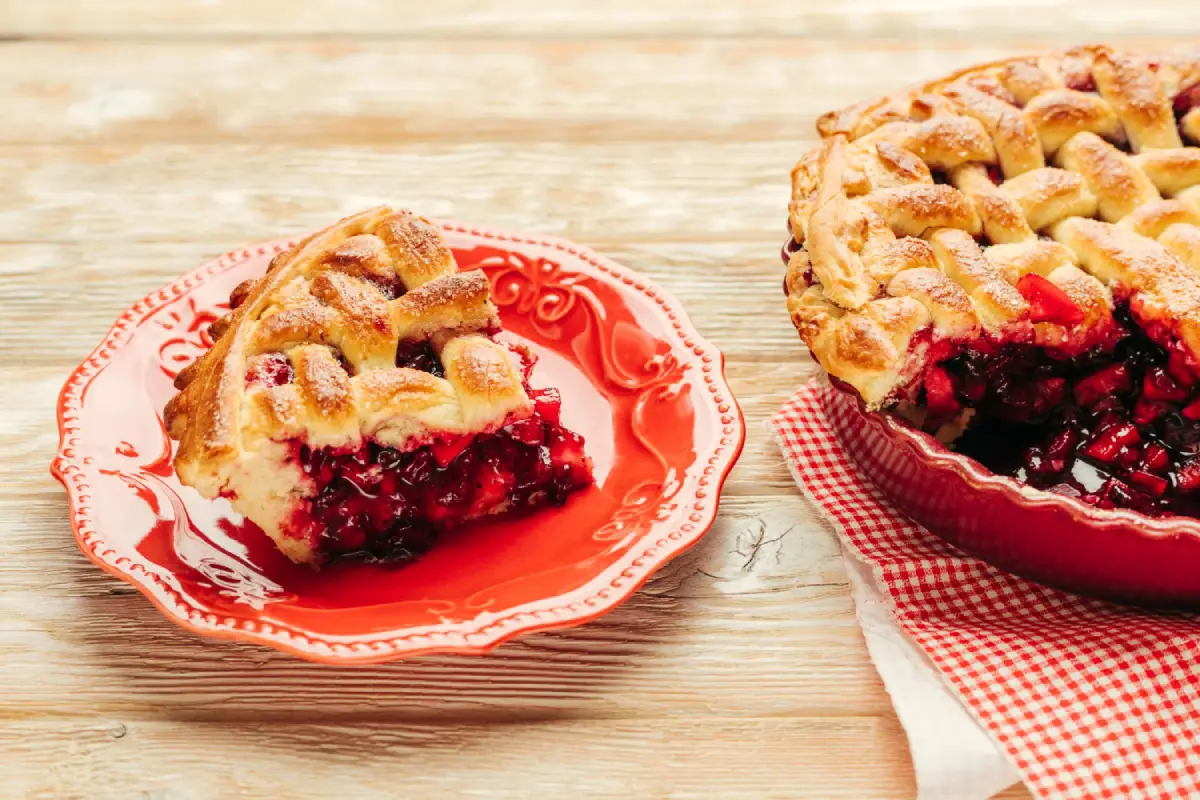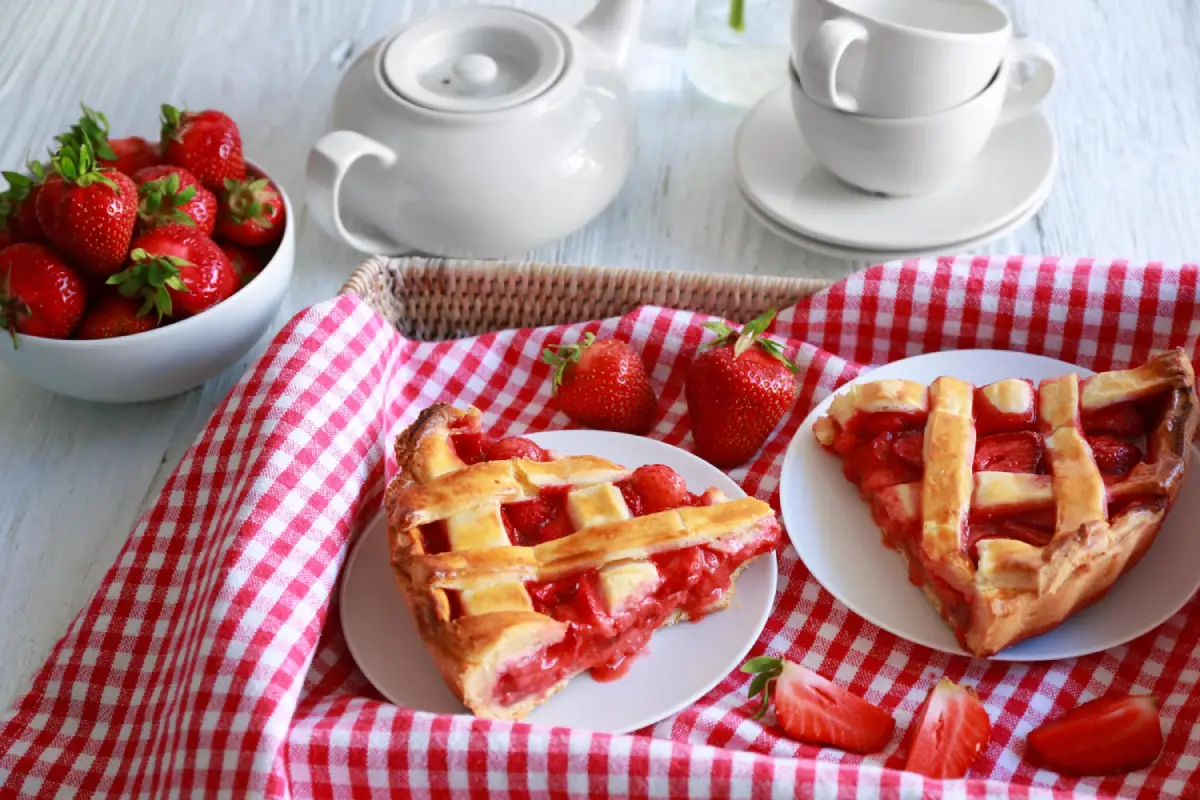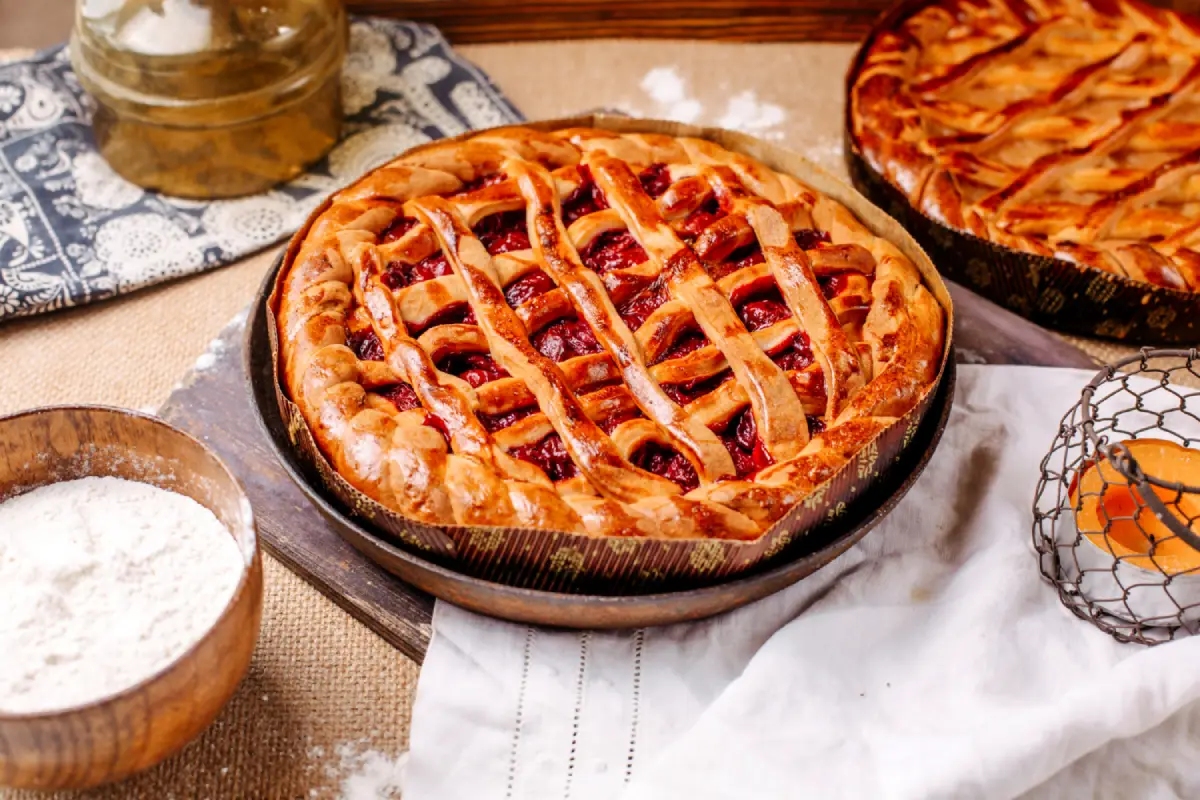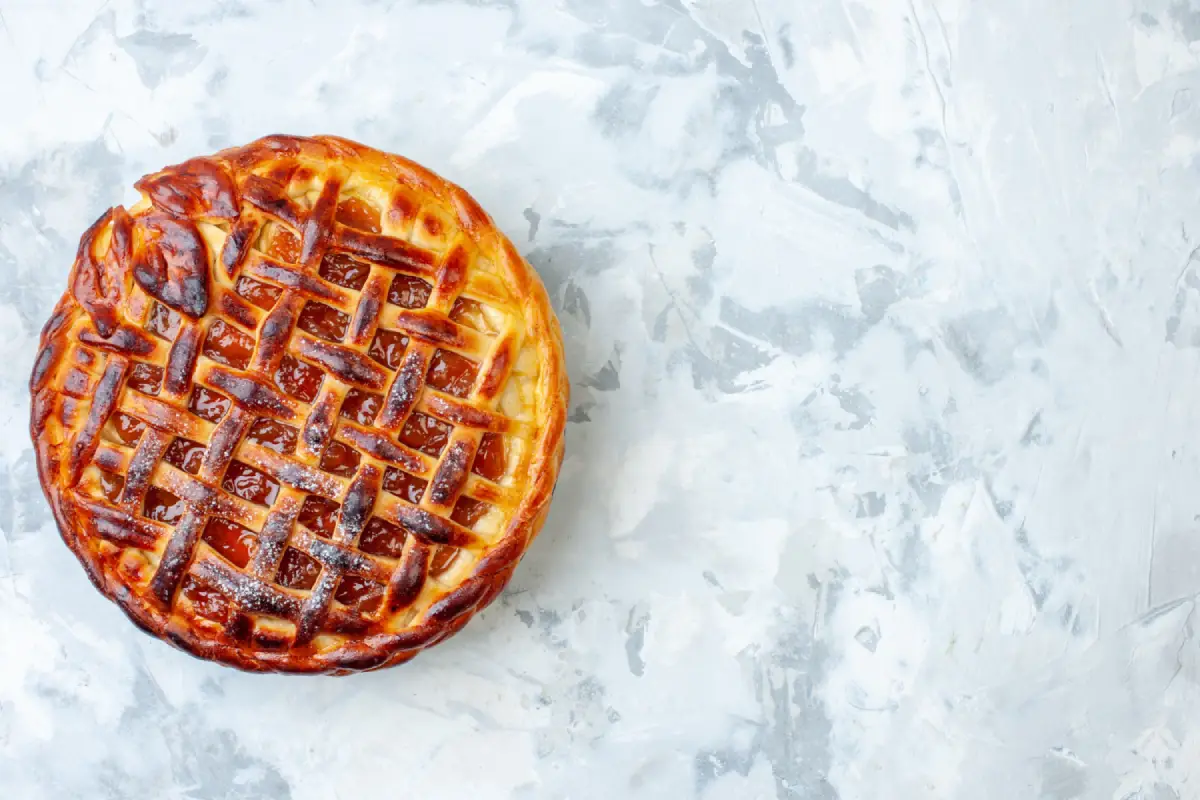Have you ever sliced into a freshly baked strawberry pie, only to find it watery? This issue frustrates many bakers. “Why does my strawberry pie get watery?” is a common question. It can turn a delightful dessert into a soggy letdown.
Strawberry pie is a favorite for its rich flavor and aroma. Yet, the juicy berries that make it delicious can also cause runny fillings. The goal is to keep the strawberries’ taste while achieving a firm filling.
This article will uncover why strawberry pie fillings turn watery. We’ll offer solutions and tips to prevent this issue. You’ll learn about thickeners, baking techniques, and more. Whether you’re a seasoned baker or a beginner, our guide will help you make the perfect strawberry pie. Join us to turn your next pie from soggy to spectacular. For a step-by-step guide on creating the perfect summer dessert, check out our Strawberry Lattice Pie Recipe.
Understanding Why Your Strawberry Pie Gets Watery
The path to a perfect strawberry pie often encounters a watery obstacle. To tackle this, let’s first delve into why such an issue arises. Here are the primary culprits behind a runny strawberry pie:
- Firstly, Juicy Strawberries: Strawberries are naturally water-rich. During baking, they release moisture into the pie, potentially leading to a soggy filling.
- Secondly, Insufficient Thickening: A common oversight is not using enough thickener or misapplying it, which can result in a filling that fails to solidify properly.
- Additionally, Underbaking: If the pie isn’t baked long enough, the filling won’t have a chance to thicken and set as it cools, contributing to a watery outcome.
- Moreover, the Cooling Process: Hastily cooling the pie or slicing it before it has completely cooled can prevent the filling from setting correctly, leading to a less-than-ideal texture.
By identifying these frequent issues, bakers can proactively adjust their approach, ensuring their strawberry pie achieves the perfect balance of flavor and texture, with a beautifully consistent filling. For an in-depth look at how different thickeners affect pie consistency, visit King Arthur Baking’s guide on thickening fruit pies.
Choosing the Right Thickener to Prevent a Watery Strawberry Pie
Thickeners are crucial for turning the watery mixture from strawberries into a perfect pie filling. Knowing how to select and apply them is key to a well-set dessert. Here’s an in-depth look at common thickeners and tips for their effective use:
- Cornstarch stands out as a top choice for fruit pies because of its strong thickening power. You should use about 2 to 3 tablespoons of cornstarch for every 4 cups of fruit. Always mix it with sugar before adding it to the fruit to prevent lumps.
- Tapioca works well with acidic fruits like strawberries, giving a slightly glossy finish. For every 4 cups of fruit, use 2 tablespoons of tapioca. Let the pie filling sit for 15 minutes before baking to allow the tapioca to soak up the juices.
- Flour, though not as strong as cornstarch, acts as a traditional thickener. It requires about 1/4 cup for every 4 cups of fruit. Mix it with sugar first to ensure it integrates smoothly into the filling.
- Pectin, although less common in pies, complements strawberries nicely. Since fruits naturally contain pectin, adding a commercial form can help set the filling. Follow the package instructions for the right amount.
Expert Tips for Using Thickeners:
- Mix the thickener evenly with the fruit to avoid a gritty texture, ensuring thorough distribution.
- Adjust based on the fruit’s juiciness: You might need to increase the thickener if your strawberries are particularly juicy. More juice generally means more thickener.
- Heat activates thickeners: Thickeners require a certain temperature to function. Proper baking is essential for the thickener to work and achieve the filling’s desired consistency.
By selecting and using thickeners carefully, you’ll be able to avoid a watery strawberry pie, ensuring a filling that’s thick, rich, and utterly satisfying.
Baking Techniques to Avoid a Runny Strawberry Pie
Achieving the perfect set for your strawberry pie involves more than just choosing the right thickener. The baking process itself plays a pivotal role. Here are some baking techniques that can help ensure your pie sets beautifully:
- Preheat Your Oven: Always start with a preheated oven to ensure consistent baking from the moment you place the pie inside. This helps the filling start to thicken right away.
- Bake at the Right Temperature: Most fruit pies bake well at temperatures between 375°F to 425°F. Higher temperatures help the thickener activate and set the filling. For more baking tips to achieve the perfect pie set, explore King Arthur Baking’s tips and techniques.
- Use a Glass or Ceramic Pie Dish: These materials conduct heat evenly, helping the bottom crust cook thoroughly and the filling to set properly.
- Bake Until Bubbling: The filling should bubble around the edges and possibly in the center. This is a clear sign that the pie has reached the right temperature internally for the thickener to work.
- Shield the Crust: If the edges of your pie crust brown too quickly, cover them with foil or a pie shield. This prevents burning while allowing the filling to continue cooking and thickening.
- Cool Completely: After baking, let the pie cool completely at room temperature. Cooling allows the filling to set and thicken further, ensuring it holds together when sliced.
By following these baking techniques, you’ll significantly increase your chances of producing a strawberry pie with a perfectly set, non-watery filling. The right balance of heat, time, and patience can make all the difference in achieving pie perfection.
Cooling Strategies for a Perfectly Set Strawberry Pie
The final, and often overlooked, step in ensuring your strawberry pie doesn’t end up watery is the cooling and setting process. This stage is as crucial as selecting the right thickener and employing the best baking techniques. Here’s how to master the art of cooling and setting your pie:
- Let It Cool Gradually: Once you remove the pie from the oven, resist the temptation to cut into it immediately. Place it on a wire rack and allow it to cool gradually. This slow cooling process helps the filling to set properly.
- Room Temperature is Key: Aim to cool the pie to room temperature before refrigerating or serving. This could take several hours, but it’s a critical step for the thickener to fully do its job.
- Refrigerate If Needed: If you prefer your pie chilled or if you’re serving it later, only refrigerate it after it has completely cooled to room temperature. Chilling a warm pie can cause condensation, which might make the filling watery.
- Slice with a Clean, Sharp Knife: When it’s time to serve, use a sharp knife to cut clean slices. A clean cut helps maintain the structure of the set filling, ensuring each slice holds together well.
- Serve the Same Day: For the best texture and flavor, serve the pie the same day you bake it. If you must store it, cover it loosely with foil or plastic wrap in the refrigerator.
By embracing patience during the cooling and setting phase, you ensure that all your hard work pays off, resulting in a strawberry pie that’s as visually appealing as it is delicious. The perfect set filling, with its rich flavor and ideal consistency, is well worth the wait.
Recipe Adjustments to Avoid Watery Filling
Achieving the perfect consistency in your strawberry pie filling can sometimes be a challenge. If you find your pie consistently turns out too watery, a few recipe adjustments can make all the difference. Here’s how to tweak your approach for a thicker, more satisfying filling:
- Macerate the Strawberries: Begin by macerating your strawberries in sugar. This step draws out excess moisture, which you can then simmer to reduce into a thick syrup. Adding this syrup back to your filling enhances the flavor without the watery texture.
- Pre-cook Your Filling: Simmering your strawberry filling on the stove before baking allows you to evaporate additional moisture. This pre-cooking stage gives you greater control over the final consistency of your pie.
- Increase Thickener Amount: If watery pies are a recurring issue, it might be time to up your thickener. Remember, the potency varies between thickeners like cornstarch, tapioca, and flour, so adjust accordingly.
- Adjust for Ripeness: The juicier your strawberries, the more moisture they’ll introduce to your pie. For very ripe, juicy berries, you may need to compensate with a bit more thickener or reduce other liquid components in your recipe.
- Bake on the Bottom Rack: Placing your pie on the oven’s bottom rack can help the bottom crust cook more thoroughly and the filling to set better, thanks to the closer proximity to the heat source.
Implementing these adjustments can help ensure your strawberry pie has a beautifully thick filling, free from the disappointment of sogginess. With each tweak, you’re one step closer to the perfect pie that’s as delightful to slice as it is to eat.
FAQs
Addressing common questions can further clarify how to achieve the perfect strawberry pie. Here are answers to frequently asked queries:
How do you keep fruit pies from being runny?
To prevent fruit pies from becoming runny, use the right amount of a suitable thickener, like cornstarch or tapioca. Additionally, letting the pie cool completely allows the filling to set properly, reducing runniness.
Why did my pie turn out watery?
Several factors can lead to a watery pie, including not using enough thickener, underbaking, and not allowing the pie to cool and set. Adjusting these elements can help achieve better consistency.
How do you make pie filling less watery?
Making the pie filling less watery involves reducing the liquid content before baking. This can be done by macerating the fruit to draw out moisture, pre-cooking the filling to evaporate excess liquid, and adjusting the amount of thickener based on the juiciness of the fruit.
Why is my strawberry filling not thickening?
If your strawberry filling isn’t thickening, it might be due to insufficient thickener or not baking the pie long enough for the thickener to activate. Ensure you’re using the correct amount of thickener for the volume of fruit and that the pie is baked until the filling bubbles.
Conclusion
Crafting the perfect strawberry pie, complete with a thick, flavorful filling and a flaky crust, is within reach by applying the insights and techniques outlined in this article. From selecting the right thickener to understanding the nuances of baking and cooling, each step plays a vital role in achieving pie perfection. By addressing common issues such as runniness and ensuring your pie is baked thoroughly, you can avoid the common pitfalls that lead to a watery filling.
Remember, the key to a great strawberry pie lies not just in following a recipe but in adapting techniques to suit the ingredients you have, especially as the juiciness of strawberries can vary. Experimentation and patience are your allies in the kitchen, allowing you to refine your approach with each pie you bake.
We hope this guide has equipped you with the knowledge and confidence to tackle the challenge of making a strawberry pie that’s as delightful to look at as it is to eat. So, the next time you find yourself wondering, “Why does my strawberry pie get watery?” you’ll know exactly how to ensure it comes out perfectly every time.
Happy baking, and may your strawberry pies be deliciously thick and satisfying!




